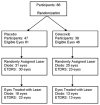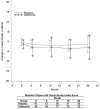Preliminary assessment of celecoxib and microdiode pulse laser treatment of diabetic macular edema
- PMID: 20038863
- PMCID: PMC3025102
- DOI: 10.1097/IAE.0b013e3181bcf1a0
Preliminary assessment of celecoxib and microdiode pulse laser treatment of diabetic macular edema
Abstract
Purpose: Inflammation may play an important role in the pathogenesis of diabetic macular edema, a major cause of vision loss in persons with diabetes. The purpose of this study was to evaluate combined antiinflammatory therapy and laser approaches for treating patients with diabetic macular edema.
Methods: In this prospective, factorial, randomized, multicenter trial, we compared cyclo-oxygenase-2 inhibitor (celecoxib) with placebo and diode grid laser with standard Early Treatment Diabetic Retinopathy Study focal laser treatment in 86 participants with diabetic macular edema. The primary outcome is change in visual acuity of > or = 15 letters from baseline, and the secondary outcomes include a 50% reduction in the retinal thickening of diabetic macular edema measured by optical coherence tomography and a 50% reduction in leakage severity on fluorescein angiography.
Results: Visual acuity and retinal thickening data from >2 years of follow-up did not show evidence of differences between the medical and laser treatments. However, participants assigned to the celecoxib group were more likely to have a reduction in fluorescein leakage when compared with the placebo group (odds ratio = 3.6; P < 0.01).
Conclusion: This short-term study did not find large visual function benefits of treatment with celecoxib or diode laser compared with those of standard laser treatment. A suggestive effect of celecoxib in reducing fluorescein leakage was observed.
Figures




Similar articles
-
Selective retina therapy (SRT) for clinically significant diabetic macular edema.Graefes Arch Clin Exp Ophthalmol. 2010 Sep;248(9):1263-72. doi: 10.1007/s00417-010-1356-3. Graefes Arch Clin Exp Ophthalmol. 2010. PMID: 20393742 Clinical Trial.
-
Microperimetry and fundus autofluorescence in diabetic macular edema: subthreshold micropulse diode laser versus modified early treatment diabetic retinopathy study laser photocoagulation.Retina. 2010 Jun;30(6):908-16. doi: 10.1097/IAE.0b013e3181c96986. Retina. 2010. PMID: 20168272 Clinical Trial.
-
A randomized trial to assess functional and structural effects of ranibizumab versus laser in diabetic macular edema (the LUCIDATE study).Am J Ophthalmol. 2014 May;157(5):960-70. doi: 10.1016/j.ajo.2014.02.019. Epub 2014 Feb 14. Am J Ophthalmol. 2014. PMID: 24531025 Clinical Trial.
-
Vascular endothelial growth factor and diabetic macular edema.Surv Ophthalmol. 2016 Nov-Dec;61(6):759-768. doi: 10.1016/j.survophthal.2016.03.010. Epub 2016 Apr 1. Surv Ophthalmol. 2016. PMID: 27045225 Review.
-
[Literature review: Diabetic macular edema. Repercussions and treatment].Rev Med Inst Mex Seguro Soc. 2015 Sep-Oct;53(5):600-7. Rev Med Inst Mex Seguro Soc. 2015. PMID: 26383810 Review. Spanish.
Cited by
-
Diabetic macular edema: therapeutic options.Diabetes Ther. 2012 Nov;3(1):1-14. doi: 10.1007/s13300-012-0002-y. Epub 2012 Mar 6. Diabetes Ther. 2012. PMID: 22392532 Free PMC article.
-
Prostanoid signaling in retinal cells elicits inflammatory responses relevant to early-stage diabetic retinopathy.J Neuroinflammation. 2024 Dec 23;21(1):329. doi: 10.1186/s12974-024-03319-w. J Neuroinflammation. 2024. PMID: 39716241 Free PMC article.
-
Eicosanoids and Oxidative Stress in Diabetic Retinopathy.Antioxidants (Basel). 2020 Jun 12;9(6):520. doi: 10.3390/antiox9060520. Antioxidants (Basel). 2020. PMID: 32545552 Free PMC article. Review.
-
Effect of systemic medications on onset and progression of diabetic retinopathy.Nat Rev Endocrinol. 2010 Sep;6(9):494-508. doi: 10.1038/nrendo.2010.122. Epub 2010 Jul 27. Nat Rev Endocrinol. 2010. PMID: 20664533 Review.
-
Lipid mediators are critical in resolving inflammation: a review of the emerging roles of eicosanoids in diabetes mellitus.Biomed Res Int. 2015;2015:568408. doi: 10.1155/2015/568408. Epub 2015 Mar 19. Biomed Res Int. 2015. PMID: 25866794 Free PMC article. Review.
References
-
- The Eye Disease Prevalence Research Group Causes and prevalence of visual impairment among adults in the United States. Arch Ophthalmol. 2004;122:477–485. - PubMed
-
- The Eye Disease Prevalence Research Group The prevalence of diabetic retinopathy among adults in the United States. Arch Ophthalmol. 2004;122:552–563. - PubMed
-
- Klein R, Klein B, Moss SE, Davis MD, DeMets DL. The Wisconsin epidemiologic study of diabetic retinopathy. IV. Diabetic macular edema. Ophthalmology. 1984;91:1464–474. - PubMed
-
- Photocoagulation for diabetic macular edema. Early Treatment Diabetic Retinopathy Study report number 1. Early Treatment Diabetic Retinopathy Study Research Group. Arch Ophthalmol. 1985;103:1796–1806. - PubMed
-
- Schatz H, Maderia D, McDonald HR, Johnson RN. Progressive enlargement of laser scars following grid laser photocoagulation for diffuse diabetic macular edema. Arch Ophthalmol. 1991;109:1549–1551. - PubMed
Publication types
MeSH terms
Substances
Grants and funding
LinkOut - more resources
Full Text Sources
Medical

